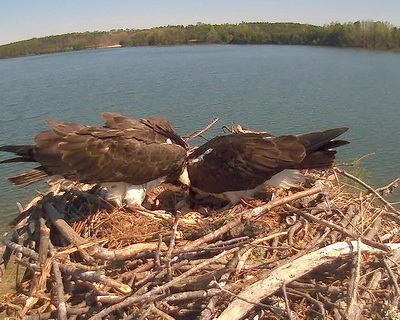OSPREY WATCH 3

All looks well on the osprey nest. The first egg arrived on March 31st, followed by three additional eggs spaced a few days apart. The osprey nest is located atop a pole and platform near the R-16 channel marker, behind the Discovery Center at Smith Mountain Lake State Park. Most of the time, the female has been sitting on the 4 eggs. Occasionally she gets relief from the male who will also sit on the eggs. The male has been keeping the female satisfied with plenty of fish to eat. He is an expert at catching fish and uses a technique only known to the osprey. When hunting, like all other raptors, the osprey will take advantage of a current of warm air produced from the sun’s uneven heating of the earth. This pocket of rising warm air is caught by the osprey and it effortlessly soars high in the sky above the water. Because of the bird’s ability to see fine detail from far away, it can spot a fish near the surface of the water. It glides towards its prey with a controlled downward slide. As it gets closer, it stops to hover using deep, labored wing-beats. Few raptors hover because it’s very wasteful energy. There is no forward motion and the bird must use its muscle power to stay aloft. It then tucks its wings tight to its body and dives. At the last moment the osprey throws its wings back and plunges into the water feet first, followed by the head. It can go under water 3 feet if it has to. After grabbing the fish with its talons, it returns to the surface and flaps its water logged feathers and flies off. As it flies, it turns the fish to point forward so it is aerodynamic, that is, it offers less wind resistance. Its catch rate has been estimated at over 40% for every attempt.
Because the osprey catches almost exclusively live fish, over many years its body has changed from other raptors, to help with the task of catching fish. It has a non-skid surface on the bottom of its feet for gripping fish. The outermost toe can swing back with the rear toe so it has two toes in the front and two toes in the back for holding on to wriggly fish. Its talons are quite long and curved for the same purpose. It is also equipped with large oil glands providing an abundance of waterproofing oil. On a few occasions an osprey will take a fish that is too large to lift out of the water and is unable to unhook its talons from the fish and drowns as a result. There have been reports of large fish being caught with osprey skeletons still attached. The osprey can take fish up to its own weight, approximately 4 pounds, but prefers a catch of about one pound. If you see an osprey in flight, it can be recognized by its large wing span of almost 6 feet, which has a bend at the elbows forming the letter “M”. An eagle, also found at the lake, has a straight across wing span. Also, when the eagle grabs a fish, it does not hover and does not enter the water, preferring to grab the fish on the fly when it is near the surface.
When the osprey brings the fish to the nest, it will already have eaten the head. Ospreys have a longer small intestine compared to other raptors. This helps them digest the fish scales and bones.
As the embryo nears 30 days in the egg, it will begin to breathe from an air pocket inside the egg. It will chirp to its mother who responds and encourages the chick to peck at the shell. It takes about a day for the chick to peck a hole big enough to exit.
by Jim Gerhart
Friends of Smith Mountain Lake State Park

